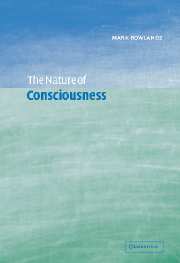Book contents
- Frontmatter
- Contents
- Preface
- 1 The problem of phenomenal consciousness
- 2 Consciousness and supervenience
- 3 The explanatory gap
- 4 Consciousness and higher-order experience
- 5 Consciousness and higher-order thoughts
- 6 The structure of consciousness
- 7 What it is like
- 8 Against objectualism II: mistakes about the way things seem
- 9 Consciousness and representation
- 10 Consciousness and the natural order
- Bibliography
- Index
8 - Against objectualism II: mistakes about the way things seem
Published online by Cambridge University Press: 22 September 2009
- Frontmatter
- Contents
- Preface
- 1 The problem of phenomenal consciousness
- 2 Consciousness and supervenience
- 3 The explanatory gap
- 4 Consciousness and higher-order experience
- 5 Consciousness and higher-order thoughts
- 6 The structure of consciousness
- 7 What it is like
- 8 Against objectualism II: mistakes about the way things seem
- 9 Consciousness and representation
- 10 Consciousness and the natural order
- Bibliography
- Index
Summary
Introduction
The objectualist interpretation of what it is like has, undeniably, a powerful intuitive appeal. If a given experience seems or feels a certain way, what could be more natural than supposing that in having that experience we are aware of the way it seems or feels? The previous chapter supplied (I) arguments against the objectualist interpretation, (II) arguments for the actualist interpretation, (III) a diagnosis of why the objectualist interpretation should be so intuitively natural even if false, and (IV) responses to objections to the abandoning the objectualist interpretation. However, such is the appeal of the objectualist account of what it is like, that it is difficult to shake the suspicion that even all this is not enough. Accordingly, this chapter develops further the case against objectualism.
In developing this case, I shall adopt the common assumption that the phenomenal constituents of the what it is like of experience are phenomenal properties or, as they are sometimes called, qualia. I shall use these terms interchangeably. Roughly, then, the idea is that if, for example, there is something that it is like to visually experience a red square, then this what it is like will be made up of a red quale, or phenomenal property, and a square quale, or phenomenal property. For those who believe that experiences are constituted by the what it is like to have them, this assumption about their relation to qualia is uncontroversial.
- Type
- Chapter
- Information
- The Nature of Consciousness , pp. 178 - 196Publisher: Cambridge University PressPrint publication year: 2001



